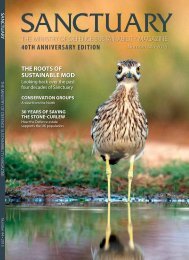SUSTAINABILITY
UBUt5
UBUt5
Create successful ePaper yourself
Turn your PDF publications into a flip-book with our unique Google optimized e-Paper software.
AROUND THE REGIONS<br />
15<br />
Monmouthshire<br />
Caerwent<br />
Grass vetchling Lathyrus nissolia © Gemma Wood<br />
Caerwent Training Area which covers<br />
600ha is renowned for<br />
Monmouthshire’s largest remaining<br />
area of limestone grassland and<br />
supports a wide range of interesting<br />
and unusual plants; elsewhere in the<br />
county most limestone grassland has<br />
been lost to agricultural intensification.<br />
The site receives frequent visits by the<br />
joint vice county recorders for the<br />
Botanical Society of Britain and Ireland<br />
(BSBI) to record plants for the planned<br />
National Atlas due to be published in<br />
2020. This involves checking historical<br />
locations of rare or uncommon plants,<br />
and monitoring and recording<br />
important species that are restricted<br />
to the county.<br />
Caerwent is the only site in the vice<br />
county for the small-flowered<br />
buttercup Ranunculus par viflorus; this is<br />
thriving in two areas but it is hoped<br />
that it will be found elsewhere.<br />
There have been apparent losses of<br />
three species – wild liquorice<br />
Astragalus glycophyllus, wild pear Pyrus<br />
pyraster and the green-winged orchid<br />
Anacamptis morio. Other orchids seem<br />
to be flourishing though, early purple<br />
orchid Orchis mascula in areas of<br />
woodland scrub and in open areas and<br />
both bee orchids Ophr ys apifera and<br />
southern marsh orchids Dact ylorhiza<br />
praetermissa on gravel areas around<br />
buildings and banks.<br />
The woodland to the north also has<br />
one of the largest populations of our<br />
native columbine Aquilegia vulgaris.<br />
Everyone knows Granny’s bonnet as a<br />
popular garden plant in many forms<br />
and colours but the plants on the base<br />
are the true native species with large<br />
deep purple single flowers.<br />
The uncommon fern Adder’s tongue<br />
Ophioglossum vulgatum grows in<br />
profusion in one field. The field and<br />
woodland margin habitats are also a<br />
stronghold for hairy violet Viola hirta.<br />
A plant more at home along the coast,<br />
the diminutive sea storksbill Erodium<br />
marinum used to be scarce at<br />
Caerwent but has undergone an<br />
amazing expansion and is now found<br />
along the edges of tracks and roads.<br />
Common cudweed Filago vulgaris,<br />
actually a rare plant despite its name,<br />
also now flourishes along some road<br />
edges and on the old railway line.<br />
There are four species of grass on the<br />
base that are in the County Rare Plant<br />
Register: upright brome Bromopsis<br />
erecta; wood small-reed Calamagrostis<br />
epigejos; meadow oat-grass Avenula<br />
pratense and the downy oat-grass<br />
Avenula pubescens, the latter having<br />
increased significantly on the base<br />
over the last few years.<br />
Madder Rubia peregrina, gromwell<br />
Lithospermum offcinale, fragrant<br />
agrimony Agrimonia procera , Viper’s<br />
bugloss Echium vulgare , large thyme<br />
Thymus pulegoides , grass vetchling<br />
Lathyrus nissolia and Dyer’s greenweed<br />
Genista tinctoria are among the<br />
treasures that occur on the base whilst<br />
commoner plants such as ragwort<br />
Senecio jacobea and field scabious<br />
Knautia ar vensis thrive and provide<br />
important sources of nectar and pollen<br />
for a range of insects.<br />
Recent discoveries in 2014 included<br />
moth mullein Verbascum blattaria and<br />
a stonewort Nitella flexilis found in a<br />
pond at the northern edge; this had<br />
not previously been recorded away<br />
from the coastal reens. Common<br />
whitlow grass Erophila verna was also<br />
recorded for the first time.<br />
Stephanie Tyler and Elsa Wood<br />
Caerwent Conservation Committee and<br />
Joint Recorders for the Botanical Society<br />
for Britain and Ireland<br />
Dyer ’s greenweed Genista tinctoria © Crown<br />
88<br />
Sanctuary 44 • 2015



